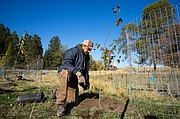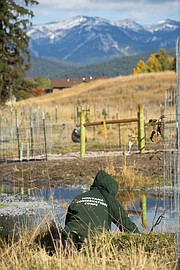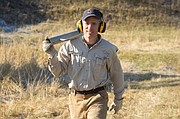HABITAT RESTORATION
For years Cow Creek has been affected by, well, cows, leading to high levels of nitrogen and phosphorous in an already-warm tributary to the Whitefish River.
In the last few weeks, however, restoration work on the site hopes to implement remedies for the years to come.
The restoration work along the creek has emerged from a partnership between a number of entities, including Whitefish Lake Institute, Flathead Conservation District, Montana Conservation Corps, Montana Fish, Wildlife and Parks, among others.
Crews recently finished work at the Barnes' property near Muldown Elementary School.
Over the years, livestock have left their mark on the stream, preventing plant cover and growth along the waterway and increasing nitrogen and phosphorous levels to the point that they exceed Montana wadeable streams criteria, WLI Executive Director Mike Koopal said.
Work being done on the site includes planting of dozens of trees, erecting fences to keep animals away from certain areas, and adding a more stable crossing for the cattle.
“Cow Creek has been a priority for us for years,” Koopal said. “It's really this community effort to restore these two reaches of Cow Creek, and it also serves as a good project demonstration for other land owners who may be considering work on their place as well.”
Cynthia Ingelfinger, science and education outreach coordinator for WLI, said the higher temperatures of Cow Creek has downstream effects.
The planting of aspen, willow, cottonwood, dogwood and other trees along the stream should help remediate those higher temperatures.
“Cow Creek is a tributary to the Whitefish River, which is impaired for temperature. Temperatures are high for cold water fisheries, so [the state Department of Environmental Quality] has identified that as a threat for the Whitefish River,” she said. “Cow Creek is lacking in a lot of riparian vegetation, which would shade the creek and keep it cooler, so if we can improve the conditions in Cow Creek, we can improve the conditions in the Whitefish River, which leads to the Flathead River and Flathead Lake.”
Funding for the project came from a $72,000 grant from the Montana Department of Environmental Quality, which the Flathead Conservation District helped secure.
A number of groups came together for the project, including River Design Group, the Natural Resource Conservation Service, Whitefish High School's FREEFLOW club, the Soil and Water Conservation Districts of Montana, the River to Lake Initiative and the City of Whitefish.
A crew of five from the Montana Conservation Corps helped with planting along the stream, which Franz Ingelfinger, Wildlife Biologist for FWP, coordinated.
Ingelfinger relates the stream and tributary system to the body's own circulatory system. While streams seem small in comparison to larger rivers, all of the streams added together makes for an overall larger area and one that can have big effects, he said.
“The headwater streams are like our capillaries, and that's where most of the exchange on the landscapes occur. It's really what's happening up here that is contributing to the flow down there,” he said.
Along with planting along the stream, cages and tubes are also being installed to protect the new trees against their primary enemies — deer, voles and weeds.
“Here, 80% of the project is simply keeping animals out of the stream and preventing trampling. Simply removing that, you've addressed the process for allowing succession to occur,” Ingelfinger said.
He added he also enjoys and appreciates the work done by the conservation corps members that have been on site.
“The MCC crew are a big resource and asset to all of us managers out here as we try to think about implementing these projects in a cost effective manner. MCC is integral to our success and it's also a great program in that's bringing our future stewards out to learn, giving them the opportunity to get their hands dirty and see conservation in action,” he said.
Hailey Graf, resource conservationist for the Flathead Conservation District, said the project has been a cool partnership to watch come together to solve a community problem.
But while all the different partners are important, it's up to the land owners to locate their needs and speak up.
After work is completed at the Barnes' property, the same group will move to the nearby Erbes' property for similar work, she said.
“Projects like this aren't possible without the private land owners. We really need land owners like the Barnes and Erbes family to help restore streams like this, and it's so important and can't be done without them,” Graf said.








